Click on image for enlarged view.
Anson Hard had a full time manager who lived at the dairy farm.
The barn is the structure in the center with the silo. Just to the north is the milk house. To the west is a storage shed for farm equipment, then the main farmhouse-- first occupied by the farm manager Harvey Wood, then by the Robinson family. At the bottom is the bull barn.
Building identifications are from Ron Bush, 14 Jan 2006. The core buildings of the farm in this picture remain, and are used by Ron Bush for the storage of his collection of historical farm equipment and tools.
The house directly across Montauk Highway was the home of Bud Stirling, a caretaker for the Hard Estate. By this time, the original Carman homestead has been removed.
By the time of this picture, no dairying was being done.
Cows at the Hard Farm. The barn is in the background.
The farm was known as Rosewood Dairy and managed by Harvey Wood for Anson Hard.
Charles Robinson is said to have purchased the duck farm about 1924, and raised Pekin Ducks. He was to become one of the larger duck farmers in Suffolk County.
The little feed railroad in the foreground was called the "Jigger."
The duck farm has now closed, and the land is owned by Suffolk County.
The following comments are from former Brookhaven Hamlet resident Richard Beyer, now of Tuscumbia, AL
I would like to add some general first-hand information to your wonderful photos of the Robinson's Duck Farm in Southaven. I worked there for two summers, 1957 between my Junior and Senior years, and 1958 following my Senior year at Bellport High School before I left for the NY State College of Forestry at Syracuse.
Ralph Robinson, one of the family members, was my Sunday School teacher at the Brookhaven Presbyterian Church. The farm was pretty much self sufficient. They had their own Incubator House, a large and expensive facility, where they hatched the eggs of ducks, chickens, and turkeys for the farm, and they also took in, when space allowed, work from other sources such as quail, pheasant and other game birds for Ken Hard's Suffolk Lodge across the highway.
The farm also had its own Feed Mill, another large another expensive facility where they could, with the best knowledge of the day, blend and produce feed for the 100,000 white ducks that were resident on the farm at any given time. I'm sure if there was any excess capacity it was put to good use in making feed for other area enterprises.
The most fascinating operation on the farm, to me at least, was the processing plant, which we simply called "the killing house" [or the "oicking house"]. In those years when I worked there it operated two days a week. When the ducks had been raised to a weight of six pounds they were "processed" and sent to market in New York City*. In that era, Long Island Duck was a very special and much sought after entree in better restaurants all over the East Coast. I even recall the names of some of the workers in the processing plant. I will spare your readers the exact processing details, which I recall very well, except to say that absolutely nothing was wasted and because the farm was run so efficiently, everything was sold except the quack. On the days the plant operated, employees were allowed to take home two ducks per person. Fifty years later I can still taste those delicious fowl and have never found any as good in markets or restaurants over the decades.
We harvested, baled and transported to the duck houses, hay from the farm's fields and from fields all over Suffolk County. The ducks were susceptible to local predators like mink and fox but even more to various diseases, especially when they were still young and yellow. One disease I recall was known as "New Duck." It must have been like a virus and it spread rapidly with a high mortality rate. The inoculation process is still vivid in my mind as it was performed at a high rate of speed and less than 100% accuracy. I was, therefore, over the two summers, inoculated in my fingers for just about every disease known to duck.
Robinson's Duck Farm was a great case study in the benefits of teamwork and efficiency and especially hard work. It was a highly educational experience for me and one for which I have always been grateful. And there are still many of us around who consider ourselves genuine environmentalists who still miss the farm and especially the Robinson family.
Best Regards,
Richard Beyer
Tuscumbia, AL
27 Nov 2006
* Ducks were shipped almost exclusively to Schweizer & Company, NYC, by truck.
Aerial view, looking north. The South Haven Presbyterian Church spire can just be seen at the horizon.
The little feed railroad in the foreground was called the "Jigger."
The farm had its own Long Island Railroad siding from which supplies were received, including bulk shipments of corn, wheat, fish meal, alafa meal, and other feeds.. It was on the southern boundary of the farm.
Ducks were shipped almost exclusively to Scheitzer & Co. by truck.


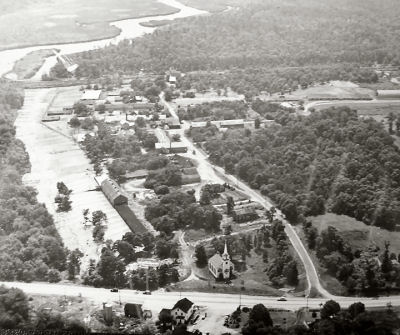
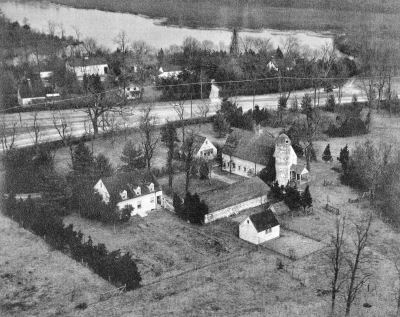
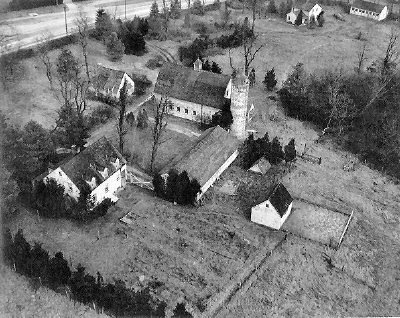
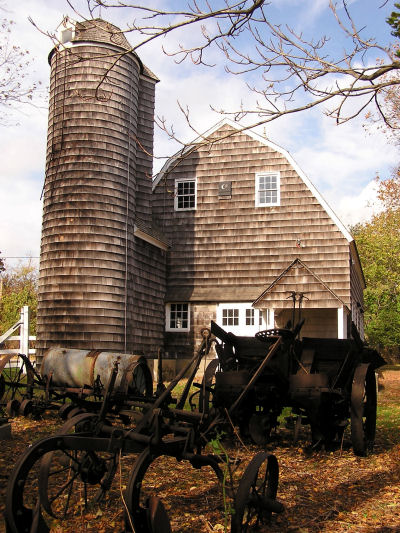
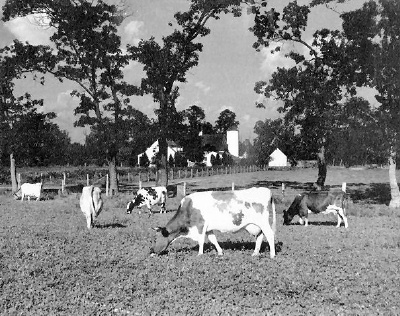
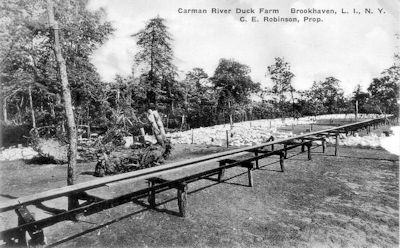
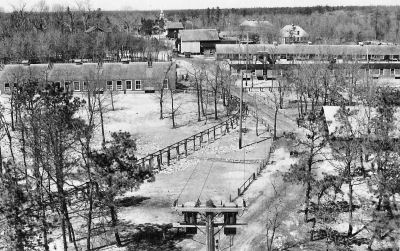
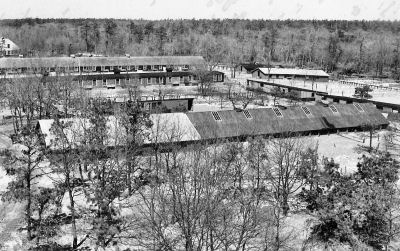
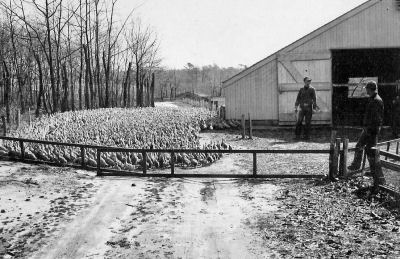
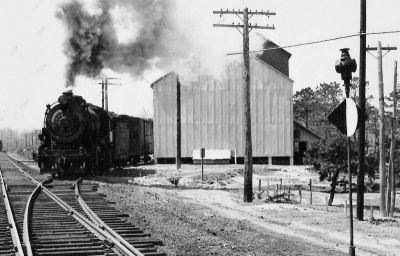
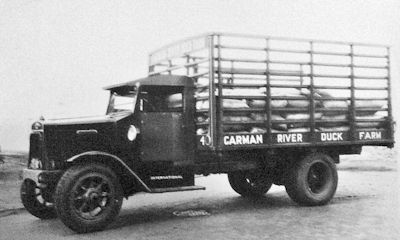
In 1948, South Haven was dominated by the Robinson duck farm (Ref. ID SH04). This aerial view is looking south. The Carman's River is in the upper left corner. The Long Island Rail Road crosses east to west at the south of the farm, and there was a siding for shipping the ducks. The duck runs are at the left. North of the rail road was the Wertheim property, which was to become the initial parcel in the Wildlife Refuge in 1948 (Ref. ID SH01A). Wertheim also owned the narrow strip of land east (left) of the duck runs to the river.
Charles Robinson is said to have purchased the farm about 1924.To the right (west) of the north/south farm road was the Anson Hard farm,said to have been acquired by him about the same time as Charles Robinson acquired the duck farm land to the left (east); this purchase was part of a larger tract of the Suffolk Club, which was to eventually become the core of the modern South Haven County Park. This was primarily a dairy farm, which was said to have been eventually leased to the Robinsons, then purchased by them about 1950.
The historic South Haven Presbyterian Church (Ref. ID Br09A) which faces Montauk Highway was nearly surrounded by the farms. I'm told that the smell of the duck farm could be nearly unbearable during much of the summer, and that was one of the reasons which lead to the church building becoming disused, then being relocated a few miles west to a new setting in Brookhaven Hamlet. Fortunately, the congregation had acquired an alternate meeting house in the old Methodist Church in Brookhaven (Ref. ID Br29C) in the early 1940's, when the Methodists and Presbyterians consolidate their congregations and structures.
In April 1991 the site, including most of the core barns and out buildings, were acquired by Suffolk County via the Trust for Public Land.